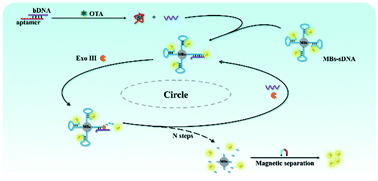Construction of a fluorescence biosensor for ochratoxin A based on magnetic beads and exonuclease III-assisted DNA cycling signal amplification†
Abstract
Specific and sensitive detection of hazardous mycotoxins in agricultural crops is one of the most important goals of food safety. A fluorescence biosensor for sensitive detection of ochratoxin A (OTA) was constructed via magnetic beads and the exonuclease III (Exo III)-assisted trigger DNA circle amplification approach. Exo III-assisted trigger DNA circle amplification can be utilized as an effective strategy for the sensitive detection of OTA. The employment of streptavidin labeled magnetic beads offers a manner for the accumulation and separation of the hairpin signal probe sDNA-FAM in solution. After target specific recognition, the aptamers combined with OTA were released and the remaining block DNA (bDNA) probes captured the signal probes on magnetic bead modified fluorophores. Subsequently, the enzyme digestion reaction leads to the fluorophore free solution. Exo III-assisted DNA circle amplification contributed to the high sensitivity of the presented OTA fluorescence aptasensor. The experimental results demonstrate that the aptasensor is sensitive with the limit of detection as low as 0.28 ng mL−1 for OTA, which was lower than that of the proposed aptasensors reported by the other literature on fluorescence methods. Additionally, the developed aptasensor with the diverse aptamer sequence shows promising potential applications in food monitoring.



 Please wait while we load your content...
Please wait while we load your content...